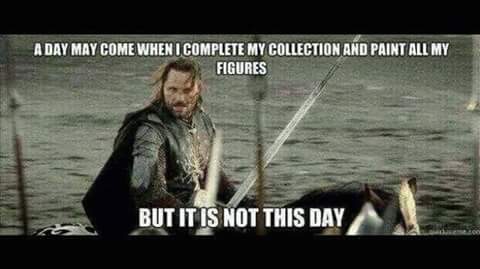In June the news came out that Dean West had been claimed by cancer. For many this was a shock since he had seemed so well just two months earlier. Our game group had enjoyed his rules The Final Argument of Kings for many years and had even had him travel hundreds of miles to game with us. So it seemed appropriate to commemorate our friend with a tribute game.
For our game we fielded seventy-three French and Austrian battalions, eighteen cavalry regiments and nineteen guns. French, Swiss, Irish and German battalions were fighting alongside the Hungarian and German battalions in the Austrian ranks. The Prussian contingent had fifty grenadier, fusilier, musketeer and Frei Korps battalions, with nineteen cavalry regiments and sixteen guns.
It is the fall, so crops are out, but the hedge and wall system makes moving in line across them like broken terrain. Columns would move freely. The town was off limits to everyone except those who could operate in open order like light infantry and grenadiers. On the 9x6' table we could deploy 18" in from the long edge and 12" from the short sides. The Franco-Austrian alliance chose the far side of the table with the town.
 |
| Bob, Andrew and Todd watch the Allies deploy. |
 |
| Dan and Paul finish the Allies with much still off table. |
The Prussians started with six brigades on table and four marked off table. Most of the cavalry started. Contrary to the usual wing deployment cavalry and infantry alternated on the front line. The Prussians were heavily weighted to the right, looking to destroy the French wing before the superiority in numbers could intervene. The Allies were also weighted on their right but held off the French main body under Soubise, all of 28 battalions.
Starting 36" apart we got in two rounds of grand tactical movement with Browne winning the first and Frederick the second. For those unfamiliar with the rule, the winning side moves and could continue winning and moving until some formed unit is within 18" of the enemy, who then get a reaction move. During that time I was pleasantly surprised to find the Franco-Austrian army moving out to meet us. I had feared we'd have to batter against line after line of defending infantry.
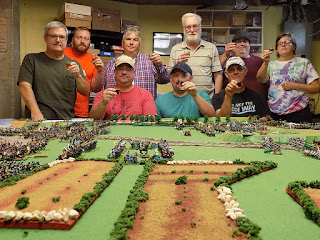 |
| To Dean: a gentleman, a scholar, and our friend. |
As soon as grand tactical was completed we paused for a toast to the memory of Dean West. Pictured from left to right are Michael (myself), Andrew, Jay (seated), Todd P., Paul (seated), Bob, Todd C. (seated), Dan and my wife Peg. Not a historical gamer but she also counted herself a friend of Dean's.
Now less narration and more just pictures. In short, a grenadier and two elite musketeer brigades assaulted on the right against mostly average French. Cavalry on our right was only facing steady infantry so could do little except absorb casualties. Elite infantry, flanked by lots of heavy cavalry came next with our far left held by Frei Korps and some jagers.
 |
| Must attack swiftly before numbers tell. |
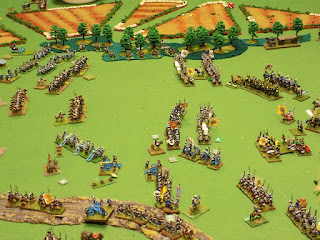 |
| The Austrians move into a killing cul-de-sac in the center. |
 |
| The Allies can't get all their troops on the table, much less in play. |
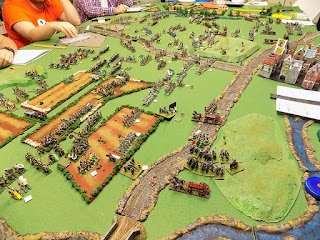 |
| Heavy cavalry begins to shift to bolster the failing French left. |
The Prussian heavy guns in the center did a great execution, though at one point they were driven from their guns by Austrian heavies, though only one was routed. Charges abounded by both sides as a see-saw struggle for the center hill ensued and the Austrians sought an advantage on their right. Many (it seemed) bloody melees were fought as opposed to the usual impact results.
 |
| View from the Prussian left with light sniping from the woods. |
 |
| The Prussians turn the corner on their right. |
 |
| A fierce struggle for the center hill rages. |
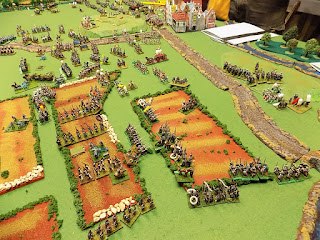 |
| The point where we paused for BBQ. |
Being Labor Day weekend we fired up two grills and indulged in yummy food and adult beverages, purely for medicinal purposes for the next two hours. Then back at it for a couple more turns.
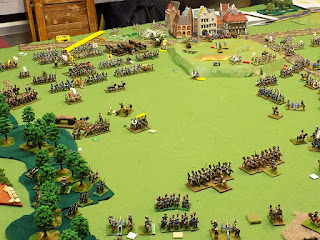 |
A lull on the Prussian left. The word goes out, "Seydlitz is dead"
and they were filled with a grim resolve. |
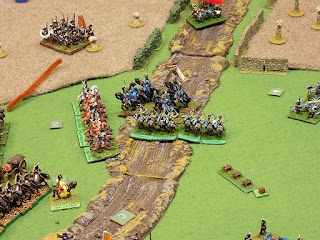 |
While chaos reigns in the center. Ammo chests represent rounds
remaining to an abandoned battery. |
 |
A second grenadier brigade has marched on and prepares to
take charge. |
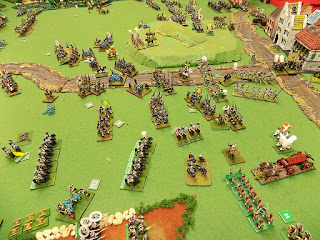 |
| Our forces close on the hill. It will soon be ours. |
We stopped for the night here, having been together about ten hours. We lost some players for Monday, even though it was a holiday, but the remainders persevered.
 |
| The last Prussian cavalry comes on. |
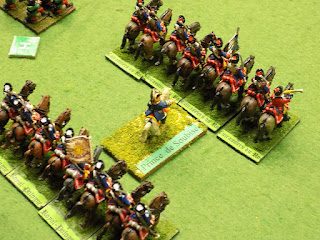 |
| But so does my nemesis with the main French body. |
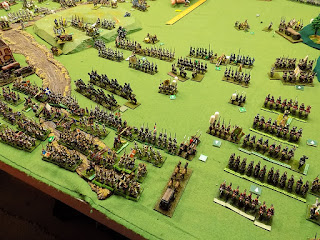 |
| Seven brigades of fresh infantry and four of cavalry arrive. Too late? |
Before we started play both sides had to note where off-table reserves were located. Both sides loaded up on their right, though the town and woods made the area for the Allies less than they desired.
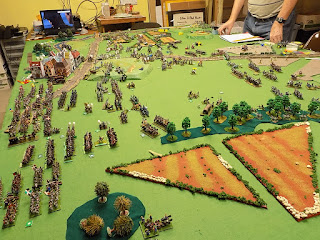 |
| Most of the playing field with the newly arrived French. |
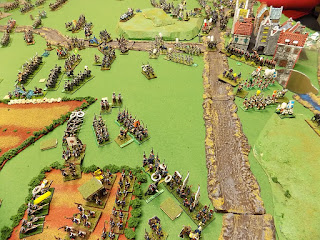 |
| Pressing them against the town. We have the hill, for the moment. |
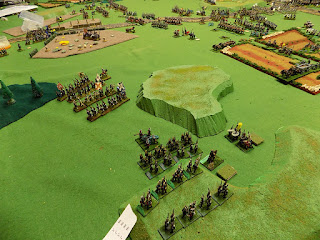 |
| A brigade of fusiliers and a mixed brigade come on for us. |
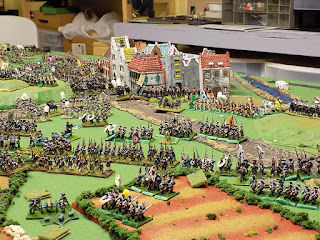 |
| This reminds me of a movie scene. |
It became obvious that the French left had been ordered to die in place so Soubise could establish a new line. I was happy to accommodate them.
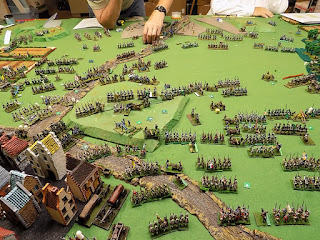 |
| What feels like a tide of white-clad soldiers rolls forward. |
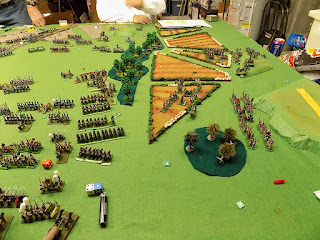 |
The host of French cavalry, much of it dubious, starts a flanking
action. |
 |
| One final small Prussian brigades double-times it to the center. |
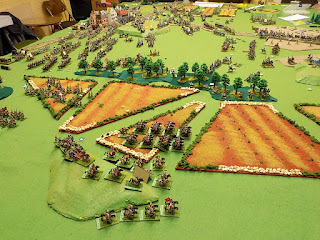 |
| Another view of the flanking maneuver. |
We wrapped it up about here. Soubise conceded a "solid Prussian victory, though not decisive." We were fine with that. All our goals had been accomplished. We'd played a special game with our core group and enjoyed a significant social time on top. I'd like to think Dean would have approved.
